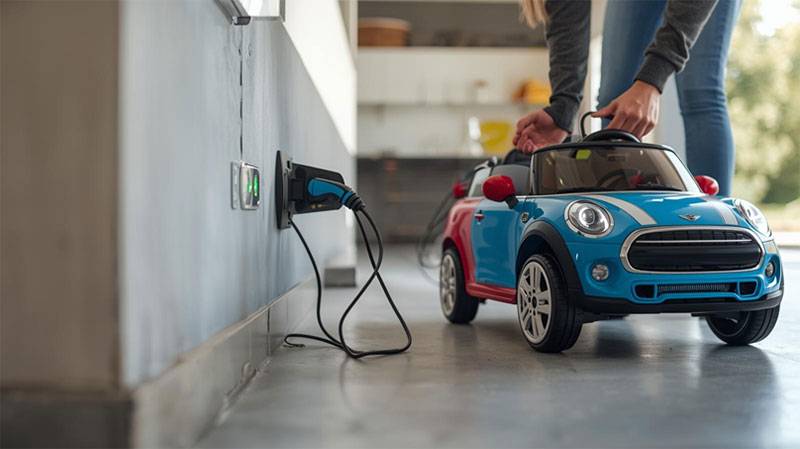How to Charge 12v Ride on Car?
To charge a 12V ride-on car, plug the charger into the car’s charging port, then connect it to a standard wall outlet. Simple stuff, but skip a step and you’ll be chasing problems later. Most 12V ride on cars in Canada use a two-prong charger, and a proper charge takes about eight to twelve hours.
Check your manual before you start—different brands have quirks, and some don’t like being treated the same way. The rundown below covers the basics, a few safety habits, and some quick answers for Canadian families running these little electric beasts.
The Charging Process
Charging a 12-volt ride-on car battery isn’t just plug-and-forget. You’ve got to babysit it a little. Batteries hate extremes, and Canada’s got plenty of both. If it’s below freezing or pushing 40°C, move it inside. A garage or basement works fine. Charging in brutal temps shortens the battery’s life faster than a kid on turbo mode.
Watch the light. Red means charging, green means full, no light means something’s wrong. Either the plug’s loose or the charger’s toast. Some ride-ons even show a fake “charging” light on the dash. Cute, but don’t trust it entirely.
Stick to the brand’s charge time. Most 12-volt batteries take 8–12 hours to go from dead to full. New ones need a monster first charge , sometimes 18 hours. That first one matters more than you think. It sets the tone for the battery’s whole life. Skip it, and you’ll pay later.
Never, ever leave it plugged in for more than 24 hours. Overcharging kills batteries , literally leaks, swells, or just dies. Want to keep tabs? Grab a cheap multimeter. While charging, you should see around 7 volts. Much lower? Battery’s getting tired. Much higher? The charger’s acting up. A quick voltage check every few hours keeps you out of trouble.
When it’s full, unplug it. Don’t trust the light. Don’t “just leave it overnight.” Set a timer. Overcharging is why most kids’ ride-ons have batteries that croak before summer’s even over.
As a rule, charge it after every ride or at least once a day if it’s used often. Never drain it completely , deep discharges kill lifespan. Keep it out of the cold, out of direct sun, and away from heaters. Stick with what the manufacturer tells you, not what a random forum says.
Battery Health
Battery health is everything. Treat it right, and your kid rides longer while you hear fewer “it won’t start” complaints. Most of it comes down to boring stuff , cleaning, charging, storing , but it adds up.
Give the terminals a quick clean every couple months. Corrosion builds fast, especially in places like Toronto where the air can’t decide if it’s snowing or raining. A soft brush does the trick. See white crust or greenish fuzz? Mix baking soda with water and scrub it off. Just make sure it’s bone dry before reconnecting.
Store it smart. Cool and dry wins. A basement’s great as long as it’s not freezing. Don’t abandon it inside the car through winter or summer. Heat warps, cold drains, and both shorten life. And yeah , no sunlight, no heaters, no “I’ll just leave it here” spots.
The first charge matters too. Eight to twelve hours, maybe more depending on the brand. Unplugging early messes with the chemical balance. Give it that one proper charge, and you’re golden.
Never use the wrong charger. A mismatched voltage , even briefly , can puff, melt, or wreck the battery entirely. Most Canadian ride-ons use 12-volt chargers, but double-check the label anyway.
And yes, overcharging again. It’s the silent killer. Leaving it on for days is like leaving your phone plugged in all week , lazy and costly. Keep it under 24 hours. Buy a timer if you’re forgetful. It’s cheaper than a new battery.
If you’re putting the car away for the winter, charge it fully first. Then, every month or so, top it up a little. Don’t let it drain to zero. Once that happens, it’s done for. No revival, no tricks, just dead weight.
Charger Types
Picking a charger for a 12V ride-on car isn’t rocket science. It’s about matching volts to volts and not frying your battery. Most ride-ons in Canada run on 6V, 12V, or 24V setups. The 12V ones? Those are the big kids , Jeeps, trucks, anything with more plastic than sense.
Each charger speaks the same language as the battery. Wrong match, and you’re either underfeeding or cooking the thing. Some chargers come from the brand that made your toy, others are generic “fits-all” types that pop up online. Three kinds matter:
| Charger Type | Features | Compatibility | Pros | Cons |
| Standard 12V | Simple plug-in, wall outlet | 12V batteries | Dead easy, usually included | No safety extras |
| Universal | Adjustable voltage (6V–24V) | 6V/12V/24V batteries | Covers multiple toys | Easy to set wrong voltage |
| Smart | Timer, auto shutoff, LED | 12V batteries | Stops overcharging | Costs more |
The standard charger is your no-drama option. Plug it in, wait a few hours, done. You’ll see them packed with Power Wheels or Peg Perego cars, plain 12V/1A bricks that just work.
Universal chargers are the “one-size-fits-all” approach. Handy if your house looks like a toy dealership, but double-check that voltage knob every single time. One wrong twist, and poof , battery toast.
Smart chargers are where things get fancy. They cut power when full, flash LEDs, maybe even show charge levels. You pay extra, but you also stop melting batteries. That’s a fair trade.
And if you’re buying third-party, stick to units with CSA or UL stamps. Canada’s got rules, and you don’t want to learn about them through smoke.
Troubleshooting Guide
Car won’t charge? Won’t run? Start at the battery. Always.
Pull out your multimeter. DC volts. Black probe to negative, red to positive. You want around 12.6V for a healthy charge. Anything way lower and it’s nap time , recharge or replace.
For the detail nerds: a hydrometer tells you even more. Hold it level, eye-height. You’re looking for specific gravity near 1.265 when full. 1.120 or less means it’s drained. Adjust for weather , subtract 0.004 for every 10°F below 80°F. Cold morning in Toronto at 50°F? Knock off about 0.012. Math sucks, but it keeps you accurate.
See swelling or burn marks? Game over. That battery’s done.
If the charger’s suspect, test it. Plug it in, hit it with the multimeter. Output should match the sticker. Hot to the touch or smelling like burnt toast? Stop using it. Don’t charge batteries when it’s freezing or baking hot , below 0°C or above 40°C. Temperature kills faster than overuse.
Winter Battery Care
Toronto winters don’t play nice with 12V ride-on car batteries. Cold sucks the life out of them. Leave one sitting too long, and by spring it’s a sad, useless brick. A little prep now saves you a lot of swearing later.
Start by giving it a full charge before storage. Not half, not “good enough.” Full. Then disconnect it if the car’s going to sit for more than a few weeks. Ride-ons still draw tiny amounts of power when off , slow drain, quiet killer.
Keep the battery somewhere cool and dry, but not freezing. Basements are usually perfect. Avoid charging anywhere below 0°C or above 40°C. Cold garages and hot sheds both wreck cells from the inside out. If your storage space feels like a meat locker, bring the battery inside when charging.
A trickle charger’s your winter best friend. It feeds just enough juice to keep things topped up without cooking the battery. Pick one with auto shutoff , they’re cheap and save you from forgetting. Still, check in every few weeks. Pop the charger on for a few hours if it’s dropped below full. Don’t let it sit empty. Ever. A dead battery that stays dead too long will freeze and never come back.
Safety First
Charging a 12V ride-on car isn’t rocket science, but it’s also not “set it and forget it.” One sloppy move and you’re risking a burnt-out battery, or worse, a safety issue. Think of this as your sanity checklist.
Battery Charging
Never use a 24V charger on a 12V battery. That’s not a small mistake, it’s an expensive one. Stick with the charger that came with the car or a legit replacement. When it’s full, unplug it. Don’t leave it overnight, don’t leave it “just one more hour.” Overcharging kills the battery and can overheat it. Always charge somewhere dry, between 0°C and 40°C. Too cold or too hot, and the battery chemistry freaks out.
Battery Maintenance
Every few charges, grab a voltmeter and check the numbers. Loose wires? Corroded terminals? Fix them. Those things cause sparks and make the car act like it’s haunted. Tight, clean connections = smooth rides.

